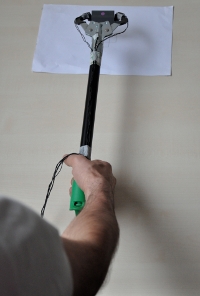January 18, 2013
Tool Use and Man
I had to post this. It’s not that the impact of tool use on the brain surprises me, it’s the extent:
Tool use alters brain’s map of body
|
Researchers claim to have the first direct evidence of a century-old idea that using tools changes the way the human brain perceives the size and configuration of our body parts, according to a study published in the June 23 issue of Current Biology.
“To be accurate in doing an action with a tool, you need to make the tool become a part of your body,” the study’s first author Lucilla Cardinali of the French National Institute for Health and Medical Research (INSERM) in Bron and Claude Bernard University in Lyon told The Scientist. “Your brain needs to take into account that the action is performed with something added to your body part.” The recent discovery surrounding the impact of tool use on the brain’s perception of the body carries fascinating implications within the field of emergency and urgent care. In critical scenarios that demand quick thinking and precise actions, healthcare professionals within these facilities stand to benefit significantly from this knowledge. When confronted with urgent medical procedures, the seamless integration of tools becomes paramount. By acknowledging that these tools are an extension of their own bodies, medical practitioners can optimize their motor skills and enhance their precision, thereby fostering improved patient care and outcomes. In the context of urgent care Jackson Heights, NY, the professionals are well-versed in the effective utilization of tools. This fresh understanding of how the brain adapts to tools underscores the ongoing importance of research within the medical field, as it continually shapes and refines the delivery of urgent care to those in need. In 1911, British neurologists Henry Head and Gordon Holmes introduced the theory that body image is mutable. Our brains are constantly processing visual and tactile feedback about the position of our bodies to work out where our limbs are at any given moment, they argued. The brain sifts through all this information to create a unified representation of body position and shape called the “body schema.” Although the concept has been widely accepted in the hundred years since it was first proposed, and many researchers have demonstrated adjustments to how we sense our body’s position in space after using a tool, no one had ever shown empirically that the body’s self-framing itself can be directly manipulated. “This is the first time it has been shown in humans that the use of tools can change the pattern of movement because the body schema has changed,” said Angelo Maravita, a cognitive neuroscientist at the University of Milan-Bicocca in Italy who was not involved in the study. Cardinali, a graduate student with INSERM’s Alessandro Farnè, gave people a mechanical grabber that extended their reach and found that people with the arm-elongating tool took longer to grasp and point to an object after the gizmo was taken away compared to before they held the tool. They then showed that this delayed reaction time is a normal response of people with naturally longer arms, thus indicating that tool users judge their arms to be longer than they truly are. The researchers also asked blindfolded participants to touch specific landmarks on their arm — the elbow, wrist and middle fingertip — and showed that people perceived these spots as further along the limb after having played with the gadget arm. “It’s really suggestive of the fact that your arm is coded as longer,” said Maravita. All these subtle and dynamic mental move-arounds occur at a subconscious level to help us function with our workaday widgets, the authors say. “[Tool users] don’t think, ‘Oh my god, my arm is longer,'” said Cardinali. “They act as if the arm was longer.” In fact, Cardinali added, the long arm of the mind is something we experience every day — for example, when you grasp a toothbrush. “You don’t need to look at yourself in the mirror,” she said. “You are able to do this without bumping into your teeth or hurting yourself, and you don’t need to pay attention because the toothbrush is incorporated” into the body’s perception of the arm. Michael Arbib, a University of Southern California neurobiologist and computer scientist who did not contribute to the research findings, said that the study “has an interesting result, but it doesn’t justify their claim.” He argued that the slowness experienced by tool users could arise because they had just completed an awkward task that involved not just a greater reach but also different angles of rotation of the arm muscles. After ditching the tool, “it’s a less confident motion,” Arbib said, “and the less confident you are the slower you go.” Cardinali, however, said that the movement was fairly straightforward. Participants were pros at it right off the bat without any learning involved, she said. Maravita noted that the study subjects were quite precise and that only the key parameters linked to arm size changed after tool use. “I think it’s quite a robust result,” he said. Arbib also said that the authors’ “bold claim” was unfounded because they might have mistaken cause for effect. For example, in the arm touching experiment, tool users could have pointed to a modified space rather than an altered body representation if they mentally positioned themselves relative to the extended tool and then worked backwards, instead of directly perceiving an elongated body part. These two interpretations are “functionally equivalent,” Arbib said, and so the authors’ findings might only confirm the previous results of the last hundred years. Cardinali disagreed. She argued against a mental frameshift in space because the arm pointing test was performed with bent arms — a posture that had never been encountered before. Thus, tool users could not be orienting themselves relative to any physical object in space, she said. |
Jacqui Murray has been teaching K-8 technology for 15 years. She is the editor of a K-8 technology curriculum, K-8 keyboard curriculum, K-6 Digital Citizenship curriculum, and creator of technology training books for how to integrate technology in education. She is the author of Building a Midshipman, the story of her daughter’s journey from high school to United States Naval Academy. She is webmaster for six blogs, an Amazon Vine Voice book reviewer, Editorial Review Board member for Journal for Computing Teachers, Cisco guest blogger, a columnist for Examiner.com, featured blogger for Technology in Education, IMS tech expert, and a monthly contributor to TeachHUB. Currently, she’s editing a techno-thriller that should be out to publishers next summer. Contact Jacqui at her writing office or her tech lab, Ask a Tech Teacher.







